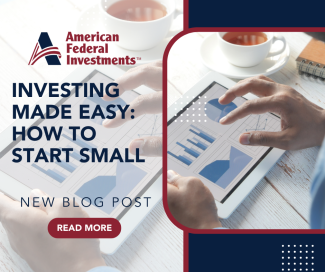
Investing Made Easy: How to Start Small
Investing is an essential tool for building wealth and independence. For some, investing may seem confusing or frustrating due to the perceived risk and complex products. While investing may initially seem intimidating, it's vital to building wealth over time.
In this article, we take the complexity out of investing to make it more enjoyable. Here are four areas of focus to help you get started on your investing journey:
- Determining if you're ready to invest
- Understanding investing terminology
- How to find extra money to invest
- Where to go for help
Determining If You’re Ready To Invest
While you may want to start investing immediately, you must be ready to invest. Here are some things to consider:
Determine the 'why'
Whether you're saving for retirement, a down payment on a house, or another long-term goal, naming the goal and tracking progress toward it can keep you on track.
Emergency savings
A staple to investing is having an emergency fund established with three to six months of expenses saved. If you carry a lot of debt, that amount may need to increase based on your situation. Should an emergency occur, your emergency fund will cover your expenses instead of your investment account prematurely liquidating. You may be ready to invest once you've established an emergency savings account.
Income
Do you have enough income left after your emergency savings, regular savings contributions, and monthly living expenses are paid? If yes, then you may be ready to start investing.
Debt
How much debt do you have, and is it high-interest debt? If you're paying interest each month and not reducing the debt, it may be appropriate to wait to invest. You must consider the rate of return on your investment and if it is comparable to or higher than the interest rate. Waiting may be appropriate if your investment performance is, at most, the debt's interest rate.
Understanding Investing Terminology
One of the first steps in your investing journey should be setting clear, realistic financial goals. Having a clear vision and written goals helps you allocate your resources efficiently and motivate you during market challenges. Your goals are unique and may vary depending on your age, income, goal timeline, and these investing fundamentals:
Risk tolerance
Every investment carries a certain level of risk, and it's important to realize how much risk you're willing to take. Risk tolerance can differ greatly from one investor to another. If the possibility of losing your initial investment keeps you awake at night, you may need to consider more conservative investment options. On the other hand, if you are comfortable with the higher risk associated with potential higher returns, you may prefer more aggressive investments.
Time horizon
Investing relies heavily on the principle of compounding, which allows for the growth of your investments over time. The earlier you start investing, the more time your money has to grow. If you start in your 20s or 30s, a small regular investment can grow significantly over time. If you’re older, you may need to invest more as you aim toward your goal.
Diversification
Diversification is critical in managing risk and working toward long-term investment goals. The idea is to invest in various assets to spread the risk; as some sectors rise, others may fall, and vice versa, thus balancing the losses. A diversified portfolio may include a mix of stocks, bonds, real estate, cash, and other investments appropriate to your situation.
As a beginner, you may want to invest in trendy or complex products you may hear about from others or the media that promise high returns. However, investing in what you understand may serve you better in the long run. It's important to ask questions about how a particular investment works, the potential risks, and how it fits your overall goals.
How To Find Extra Money To Invest
You can always start small if you need clarification on whether you have money to invest. For example, invest $50 per paycheck or $100 monthly. Here are some other actions to help you find extra money to invest:
Create a budget
A budget is a system that allows you to view and plan for your income and expenses over a set period. Budgets enable you to determine where you can cut expenses so you can allocate the money toward investing.
Lifestyle changes
Skip the daily latte, eat out two times less per month, pack a lunch, work a side hustle, cancel unused subscriptions, or downgrade streaming channels. Small lifestyle changes can equate to extra money to invest.
Automate your investing
Consider automating your investing each month; think of it as 'set it and forget it,' and watch your investments accumulate in value. Another reason for automating your investing is for dollar cost averaging (DCA) purposes. DCA enables you to purchase shares at various costs
Allocate part of your savings to investing
Making money work for you is essential to wealth accumulation. You must weigh risk and reward and determine if transferring part of your savings or allocating a percentage of it to investing makes sense for your situation.
Where To Find Help
A financial professional can be a resource for a beginning investor or one who has already started investing. Before providing guidance and recommendations, they will consider your financial resources, needs, risk tolerance, investment goals, and timeline. Financial professionals act as fiduciaries, which means they must consider these essential things and put your interests before their own when making investment recommendations.
While investing may initially seem daunting, understanding these fundamentals can help make your investing journey more manageable. It's essential to seek financial help, be patient, and routinely review your portfolio and progress toward your goals. Happy investing!
Sources:
https://www.nerdwallet.com/article/investing/how-to-invest-100
https://www.forbes.com/sites/pattieehsaei/2023/10/12/you-can-afford-to-invest-start-with-just-100-per-month/?sh=4fd2ba635903
Important Disclosures
The opinions voiced in this material are for general information only and are not intended to provide specific advice or recommendations for any individual. To determine which investment(s) may be appropriate for you, consult your financial professional prior to investing.
Investing involves risks including possible loss of principal. No investment strategy or risk management technique can guarantee return or eliminate risk in all market environments.
There is no guarantee that a diversified portfolio will enhance overall returns or outperform a non-diversified portfolio. Diversification does not protect against market risk.
All information is believed to be from reliable sources; however, LPL Financial makes no representation as to its completeness or accuracy.
This article was prepared by Fresh Finance.
LPL Tracking #517356-03

